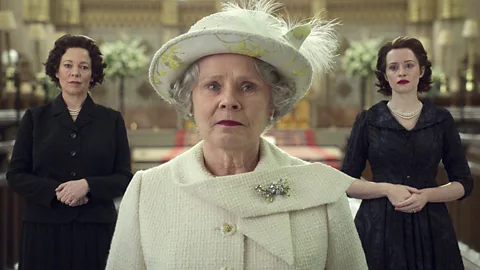The one thing The Crown got wrong
 Netflix
NetflixAs the finale of Peter Morgan's six-season series of The Crown is released on Netflix, why did the once-ired British Royal Family drama go downhill?
Queen Elizabeth II is missed in so many ways. In reality, the worldwide mourning of her death in 2022 was a poignant reminder of her importance over the 70 years of her reign. And on screen, her diminished presence over the last two seasons of The Crown answers the question: what went wrong with the show?
More like this:
- The Crown season 6 review: 'A clumsy, predictable end'
Now that writer Peter Morgan's opulent, six-season fiction about her life has ended, the long view reveals that the more the series focused on the Queen, the better it was. There is wide agreement that the show's last two seasons were far weaker than its glorious earlier days, and these recent episodes often left the Queen standing in the background, or nodding at Tony Blair and sighing at Prince Charles.
Yet the key to the show's success had always been how smartly it pulled back the curtain and filled in intimate emotional details to suggest what she might have been like behind her pleasant, enigmatic public presence. Political and family machinations swirled around her, from the Suez Crisis to dealing with a sister who drank too much, but her character was always the strong centre.
Claire Foy as the wide-eyed young Queen was full of hope and not a little insecurity about living up to her title. Olivia Colman took over seamlessly as the middle-aged Queen, now solidly sure of herself but grappling with personal and political headaches, responding to a coal miners' strike and worrying that Charles had fallen for an inappropriate woman, Camilla Shand. Their characters were based on psychologically astute speculations – she must have had doubts and dark moments – that made her come to life as more than a figurehead. Imelda Staunton as the older Queen was calmer and, in an intriguing if less convincing bit of guesswork, privately rattled about the future of the monarchy itself. If that Elizabeth had less impact, it is partly because Staunton was so vastly underused in the series.
Morgan's successful formula of hewing close to known facts and believably filling in the rest marked his breakthrough film The Queen (2006), about her slow public response to Diana's death, and his play The Audience (2013), about Elizabeth's famously private weekly meetings with her prime ministers. He carried the strategy brilliantly into The Crown.
And he surrounded Elizabeth with sharply drawn characters and performances, with an unlikely John Lithgow as a kind but wily Winston Churchill, her first prime minister, and Gillian Anderson as the sharp-edged Margaret Thatcher. Princess Margaret evolved from Vanessa Kirby’s beautiful wild child to Helena Bonham-Carter's jet-setting sybarite and Lesley Manville's subdued loyal sister.
And while there was endless grousing about how true to history The Crown was, it was often so close that the fuss was about the details. The assistant to Churchill who died in The Great Smog of 1952 in season one might have been fictional, but thousands did die during that long-forgotten event, one of many the show restored to mainstream culture. The series often worked perfectly as a history lesson wrapped in a family melodrama.
But the last two seasons gave viewers just what no one needed: more of Diana and Dodi, Charles and Camilla, Will and Kate; all of the tabloids' greatest hits. The problem was not simply that the story inched closer to the present, although that was an issue too. There are many fewer blanks to fill after the world has read transcripts of Charles and Camilla's private "want to be your tampon" phone conversations.
A bigger problem is that what speculation there was became strained and less astute. Some of it went wildly off the rails, nowhere more so than in Morgan's obsession with abdication. Last season, it was Charles' fictional conversation with Prime Minister John Major about nudging the Queen out, a scene that caused a backlash. A variation comes back in the series' clunky final episode.
Morgan was clearly straining to cast an eye ahead to acknowledge Elizabeth's death even though the chronology of the show ends in 2005. In an instalment that crams too many things together, the Queen and Prince Philip plan their own funerals – the green Land Rover he chose as a hearse makes an appearance – and in a true fictional whopper (spoiler ahead), the show suggests that on the very day of Charles and Camilla's wedding, the Queen was very close to announcing she had decided to abdicate, something every report out there suggests she would never have done barring real incapacity.
The series' very last shot might unintentionally bring to mind the sketch that went viral after her death of the Queen and Paddington Bear walking away. That laughable connection suggests how far the show drifted from its magnificent beginnings by losing sight of its believably real heroine.
The Crown season six part two is on Netflix now.
